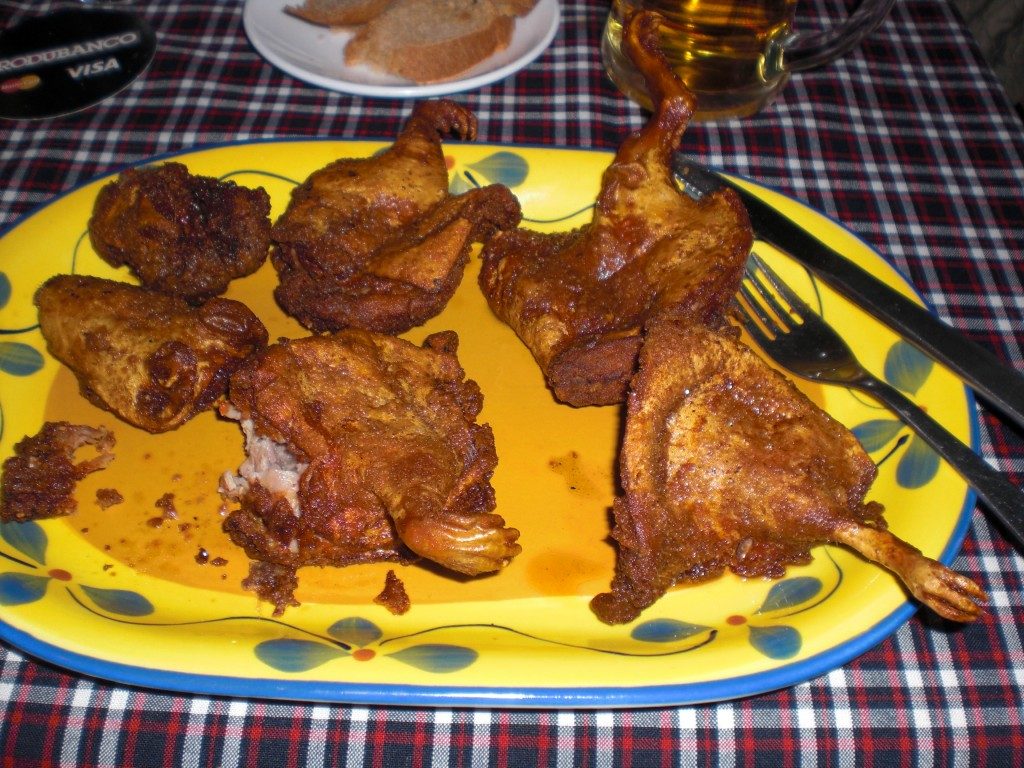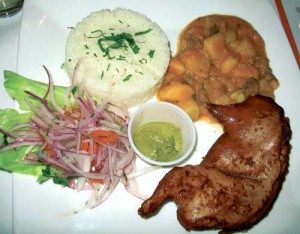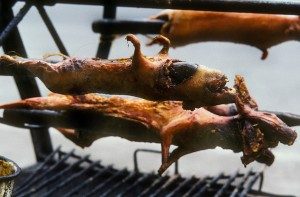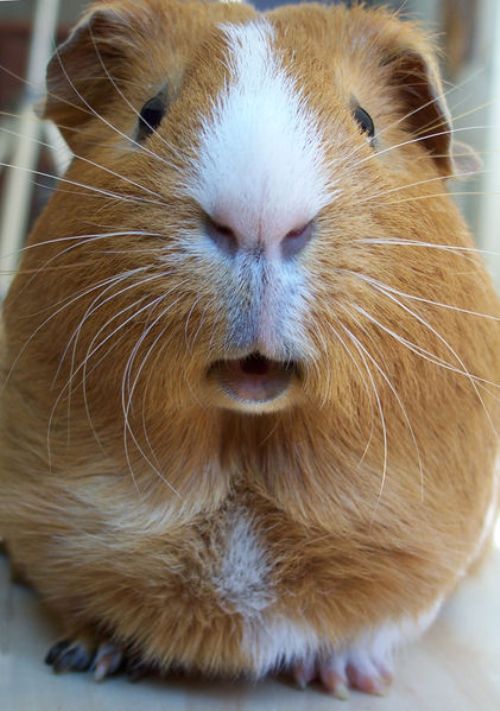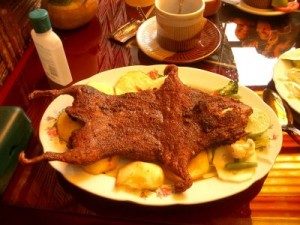Peruvians eat more than 65 million guinea pigs every year. That should answer any question about edibility.
Sixty-five million guinea pigs (a 2005 figure) is more than two rodents for every every man, woman, and child in that county. Peruvians have been consuming the pseudo-porcines for some four thousands years. The furry piglets… (figlets?) …reportedly provide half of the needed daily protein for Peruvians. Known as Cavy, Cuy and a lot of other native names, they have more protein and less cholesterol than beef, pork, or chicken (21% protein, 8% fat.) They’re also vegetarians, eat grass and behave much likes cows… except they aren’t milked… While run-of-the-house Cavy weight one to two pounds specially bred livestock guinea pigs can weight up to seven pounds. And they aren’t pigs, nor are they from Guinea.
Scientifically they are Cavia porcellus, and are not found in the wild. Cavia (KAY-vee-ah) is Dead Latin for Cabiai which is what the Galibi Indians called them. The Galibi Indans were once native of French Guiana, which is possibly where the Guinea part of the name came from. Porcellus (poor-SELL-us) is Dead Latin for “little pig.” Cavy are somewhat shaped and colored like pigs and have among their various sounds grunts hence porcellus. When all of that is combined and abused into English we get Guinea Pig. They also have a huge number of names mangled in various other languages ranging from Meerschweinchen in German (sea piglet, because they also make grunting noises like a dolphin) Helanzhu (荷蘭豬) in Chinese (which means Holland Pig) to the Spanish conejilo de Indias (little rabbit of the Indies.) Later the ruderal rodents were used for a lot of medical research and lent their common name to anyone who was being used for an experiment.
As you may guess I am in contact with a lot survivialists. I have talked with quite a few who have argued earthworms are a good thing to raise for food. I will admit native American ate them, and you can read about that here. And some have argued mushroom raising is the key to survival should society fall apart, or aquaponics. But none have ever mentioned raising guinea pigs yet they are among the most prolific, easiest and least costly of all table meats to raise. They outbreed rabbits and can be raised indoors in suburbia on vegetable table scraps. A concern of 22 breeding guinea pigs (two guys and 20 girls) will meet the protein requirments for a family of four annually producing 160 to 200 guinea pigs a year. That same stock if not eaten immediately can produce 6,000 guinea pigs within two years. Many Peruvians have a home business of raising guinea pigs. However, it must be said they are not neat animals and do require cage policing. One of the odd things about guinea pigs is like humans they cannot make vitamin C and must get enough of it in their diet or get scurvy. Some common plants are toxic to guinea pigs. They include: Parsley, wild mustard, dandelions, blackberries, coriander, and green potato peels. And like humans and monkeys, they can also get poison ivy rashes.
Of course the other culinary issue is they are cute, in a Bambi’s-not-for-dinner sort of way, and are pets. Eating or killing them for food in California is illegal because they are a pet animal. While they are edible in New York State the city of New York made them illegal… too salty? No, they were being served at Euadorian festivals in the city and someone frowned upon food that resemble the city’s infamous wharf rats. I can hear the bureaucratic argument now: Without proper inspection you don’t know whether you’re eating a wholesome guinea pig or a disgusting wharf rat thus…
California law “prohibits any person from possessing, importing into the sate [or exporting from the state] selling, buying, giving away, or accepting any carcass or part of any carcass of any animal traditionally or commonly kept as a pet or companion with the sole intent of using or having another person use any part of the carcass as food.” The same law also prohibits the killing of pet/companion animals for food. That would cover not only guinea pigs in California but dogs, cats, pot-bellied pigs, horses, pet chickens, iguanas, pigeons and the like… thought you Californians should know. Oh, and deceased, flash frozen, ready to cook guinea pigs cannot be imported into Canada, as of March 2011. The problem is not the guinea pig per se. Canada does not allow any meat to be imported from Peru as of this writing. You can read about the official Canadian Guinea Pig Swat Team here. On the other hand, raising and dispatching guinea pigs for food for your own personal use is allowed in Australia. Guinea pig meat can also be imported into the United States, where not prohibited.
Two-month old guinea pigs that will be used for food are not fed for at least 15 hours. They are then knocked senseless from behind, their jugular cut then hung upside down to drain. This renders the meat white when cooked. The whole guinea pig is dipped in near boiling water for 20 seconds. This makes the hair easy to remove. The hair is then removed. The animal is slit from anus to neck without cutting visera to avoid cutting the gall bladder. The visera is removed and the cavity rinsed (also the site of where much stuffing is stuffed or to hold sauce.) Head and feet are removed for aesthetic reasons but there is no consumption reason to remove said. Head, heart, lungs, liver and skin are also edible. In their native countries guinea pigs are usually cooked and served splayed. Different sensibilities determine plating in other areas. Younger guinea pigs are fried or grilled and the like. Older ones are roasted or stewed. Guinea pig is somewhat chewy and is usually served hot because the meat softens on cooling. The morsels are served numerous ways and when folks in Peru wax on about how their mother used to cook the guinea pig is the topic de jour. Down home cooking, Peruvian style.
If you prefer guinea pigs in your lap as pets and find the notion of eating one close to cannibalism there are many non-profit havens for the rescue, rehabilitation and adoption of guinea pigs, particularly in California. It is a good cause because we humans have a tacit agreement with the animals we domesticate as pets. They give us companionship and in exchange we don’t eat them. There is probably a guinea pig rescue near you if you want a little pet rather than a little meal. Just search for guinea pig and rescue.
For the more cuisine minded:
Cuy Chaqtado
Fried Guinea Pig (Ayacucho-style)
1 guinea pig, de-haired, gutted, and cleaned
1/2 c. flour
1/4 – 1/2 t. ground cumin
salt and black pepper to taste
1/2 c. oil
Pat dry the skin of the guinea pig and rub in the cumin, salt, and pepper. Preheat oil. Dust the carcass with the flour and place it on its back in the oil, turning to cook both sides. Alternately, the guinea pig can be cut and fried in quarters.
Serve with boiled potato or boiled manioc root, and a salad of cut tomatoes and slivered onions bathed in lime juice and a bit of salt.
Cuy Picante Huanuqueño Style*
*Ingredients: *
*- **2 large guinea pigs*
*- **1 tablespoon crushed garlic*
*- **1½ teaspoon salt *
*- **1½ pepper*
*- **1½ teaspoon cumin powder*
*- **2 tablespoons aji panca (a Peruvian deep-clay red chile, liquefied in a blender)*
*- **2 tablespoons aji mirasol (a Peruvian dark yellow chile, liquefied in a blender)*
*- ** 1 cup cooking oil or margarine *
*- **10 scallions *
*- **The guinea pigs’ hearts, livers (and in an authentic version, also the intestines, thoroughly cleaned) *
*- **1 tablespoon of crushed peanuts*
*- **8 yellow potatoes boiled and skinned*
*Preparation: *
*Cut and quarter the guinea pigs, salt and pepper, then fry until golden brown. Put aside in a warm dish. In a heavy skillet, lightly greased with a few splashes of oil, combine the garlic, aji panca and aji mirasol over high heat. Mixing and scraping the ingredients from the bottom of the pan to keep it from sticking; continue until the mixture is thoroughly cooked to a golden brown. Chop the scallions, separating the white bulbs from the green stalks. Add the finely chopped scallion bulbs to the pan with the cumin. In a separate pan, combine the hearts, livers and peanuts and cook until thoroughly done, then place in a food processor or blender to liquefy. Add and mix with aji-garlic mixture in heavy skillet. Add guinea pig pieces, cooking for 10 to 15 minutes. Let stand for at least 15 minutes. Serve over sliced boiled potatoes sliced.
Serves four.*
“Picante de cuy” – Guinea Pig with spices
The whole guinea pig is marinated overnight in spices, including cumin, black pepper, paprika and dried red chillies.
Red and yellow peppers are also liquidised and added to the marinade just before cooking.
After marinating, the meat is barbecued and served whole, but split in two like a fillet.
“Cuyes en salsa de mani” – Guinea pigs with peanut sauce
The guinea pig is seasoned whole with salt and pepper and then slowly deep fried in vegetable oil.
It is then served with a creamy peanut sauce and traditionally accompanied by white rice, fried yuccas and boiled sweet potatoes.

